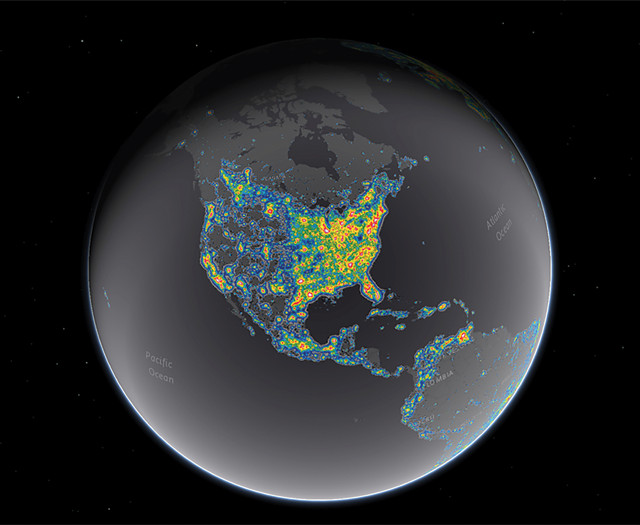
by Lucas Joel Wednesday, September 21, 2016

A map of North America from the New World Atlas of Artificial Sky Brightness. Warmer colors indicate where the glow from artificial light most obscures stars from view in the night skies. Credit: Falchi et al., Science Advances, June 2016; Jakob Grothe/National Park Service, Matthew Price/CIRES/CU-Boulder.
Death Valley National Park is a remote place, and in its night sky countless stars, including many in our own Milky Way Galaxy, are visible. But on the park’s eastern horizon, a dome of light appears each night, blotting out stars in that part of the sky. The glow of city lights from Las Vegas creates this “light pollution,” which worldwide now hides the Milky Way from about one-third of humanity, according to a new study in Science Advances.
The Milky Way appears as a diffuse, but distinct, band of light across clear night skies. “It’s a big part of our connection to the cosmos, and it’s been lost” to a lot of people, said Chris Elvidge, a scientist at NOAA’s National Centers for Environmental Information in Boulder, Colo., and a co-author of the study, in a press release.
To estimate how many people live under light-polluted skies, the researchers constructed a global atlas of light pollution using satellite data and sky brightness measurements from around the world. Light pollution, not surprisingly, is worst around major metropolitan regions: The researchers reported that about 99 percent of people in heavily developed countries like the United States and some in Europe live under skies polluted by light to some extent. Additionally, roughly 80 percent of North Americans and 60 percent of Europeans cannot see the Milky Way each night from where they live.
The researchers proposed that future technology may help curb light pollution, suggesting, for example, that street traffic could be monitored by sensors that control streetlight brightness: If traffic is low, the lights could be dimmed or turned off completely. Also, if driverless cars become ubiquitous, then streetlights might become unnecessary altogether, they wrote.
© 2008-2021. All rights reserved. Any copying, redistribution or retransmission of any of the contents of this service without the expressed written permission of the American Geosciences Institute is expressly prohibited. Click here for all copyright requests.